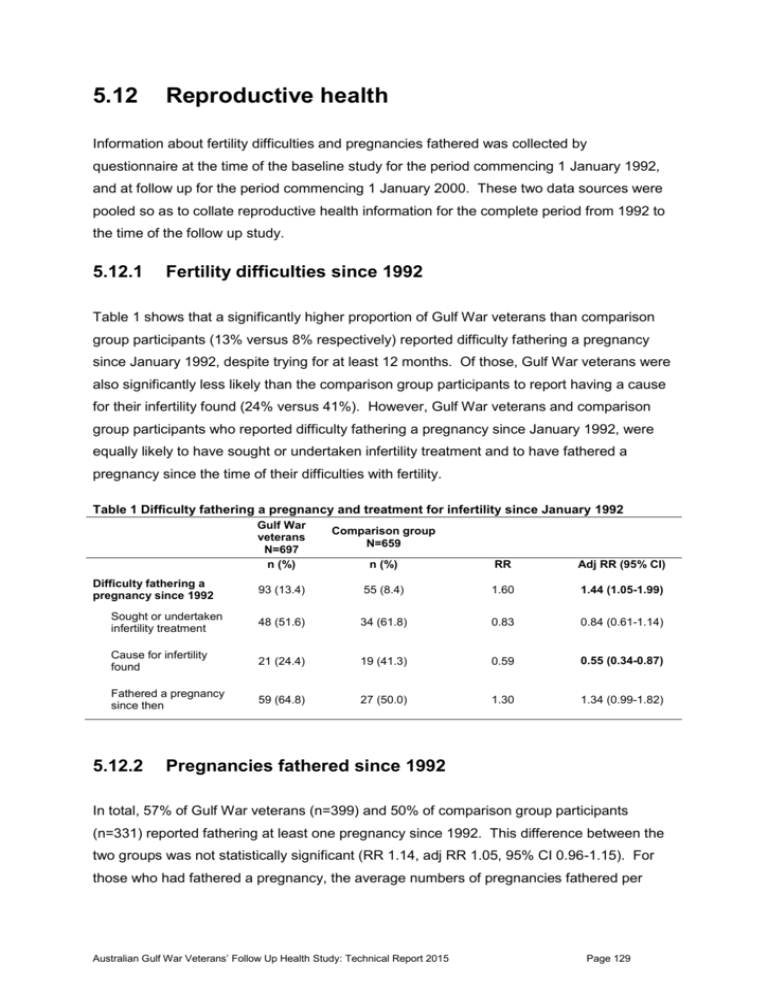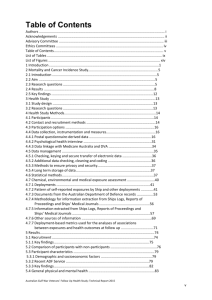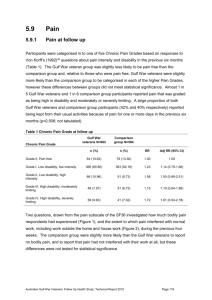Reproductive health at follow up
advertisement

5.12 Reproductive health Information about fertility difficulties and pregnancies fathered was collected by questionnaire at the time of the baseline study for the period commencing 1 January 1992, and at follow up for the period commencing 1 January 2000. These two data sources were pooled so as to collate reproductive health information for the complete period from 1992 to the time of the follow up study. 5.12.1 Fertility difficulties since 1992 Table 1 shows that a significantly higher proportion of Gulf War veterans than comparison group participants (13% versus 8% respectively) reported difficulty fathering a pregnancy since January 1992, despite trying for at least 12 months. Of those, Gulf War veterans were also significantly less likely than the comparison group participants to report having a cause for their infertility found (24% versus 41%). However, Gulf War veterans and comparison group participants who reported difficulty fathering a pregnancy since January 1992, were equally likely to have sought or undertaken infertility treatment and to have fathered a pregnancy since the time of their difficulties with fertility. Table 1 Difficulty fathering a pregnancy and treatment for infertility since January 1992 Gulf War veterans N=697 n (%) Comparison group N=659 n (%) RR Adj RR (95% CI) 93 (13.4) 55 (8.4) 1.60 1.44 (1.05-1.99) Sought or undertaken infertility treatment 48 (51.6) 34 (61.8) 0.83 0.84 (0.61-1.14) Cause for infertility found 21 (24.4) 19 (41.3) 0.59 0.55 (0.34-0.87) Fathered a pregnancy since then 59 (64.8) 27 (50.0) 1.30 1.34 (0.99-1.82) Difficulty fathering a pregnancy since 1992 5.12.2 Pregnancies fathered since 1992 In total, 57% of Gulf War veterans (n=399) and 50% of comparison group participants (n=331) reported fathering at least one pregnancy since 1992. This difference between the two groups was not statistically significant (RR 1.14, adj RR 1.05, 95% CI 0.96-1.15). For those who had fathered a pregnancy, the average numbers of pregnancies fathered per Australian Gulf War Veterans’ Follow Up Health Study: Technical Report 2015 Page 129 participant was the same for the two groups; equalling 2.1 (sd 1.4) in the Gulf War veteran group and 2.1 (sd 1.4) in the comparison group (RR 0.99, adj RR 0.98, 95% CI 0.89-1.07). The total number of fathered pregnancies reported since 1992 was 910 by the Gulf War veteran group and 760 by the comparison group. The outcomes of these pregnancies are shown in Table 2. Gulf War veterans and comparison group participants were equally likely to father a pregnancy that resulted in a live birth, miscarriage, still birth or termination. Further information, about those pregnancies which resulted in a live birth, is shown in Table 3. There was no statistically significant difference between the two study groups in regard to the proportion of live births which were premature, of low birth weight or of very low birth rate. Approximately 90% of live born Gulf War veteran babies, and 85% of live born comparison group babies were full-term and normal birth weight. Table 2 Outcome of pregnancies fathered since 1992 Gulf War veterans’ pregnancies N=910 n (%) Comparison group pregnancies N=760 n (%) RR Adj RR (95% CI) Live birth 736 (80.9) 611 (80.4) 1.00 1.00 Miscarriage 132 (14.5) 112 (14.7) 0.98 0.99 (0.75-1.31) Pregnancy outcomes Still birth 5 (0.6) 6 (0.8) 0.69 0.64 (0.20-2.12) Termination 37 (4.1) 31 (4.1) 0.99 1.02 (0.63-1.67) Gulf War veterans’ live births N=736 n (%) Comparison group live births N=611 n (%) RR Adj RR (95% CI) Premature birth (<= 36 weeks) 78 (10.6) 94 (15.4) 0.69 0.67 (0.42-1.05) Low birth weight (<2500 grams) 65 (8.8) 76 (12.4) 0.71 0.70 (0.42-1.17) Very low birth weight (<1500 grams) 16 (2.2) 12 (2.0) 1.11 0.84 (0.26-2.73) Table 3 Live birth outcomes since 1992 Live birth outcomes 5.12.3 Reproductive health at follow up In the postal questionnaire, significantly more Gulf War veterans than comparison group participants reported impotence which had been doctor-diagnosed or treated since January 2001 (the approximate time of the baseline study); 8.5% versus 4.5% respectively, RR 1.89, adj RR 2.06, 95% CI 1.30-3.29. Gulf War veterans were also more likely than the comparison group participants to report problems with sexual functioning in the month prior Australian Gulf War Veterans’ Follow Up Health Study: Technical Report 2015 Page 130 to follow up (32% versus 24%, RR 1.35, adj RR 1.39, 95% CI 1.17-1.65) and loss of interest in sex in the month prior to follow up (43% versus 32%, RR 1.33, adj RR 1.34, 95% CI 1.161.54). 5.12.4 Key findings Gulf War veterans were significantly more likely than comparison group participants to report difficulty fathering a pregnancy since January1992, despite trying for at least 12 months (13% vs 8% respectively). Of those who reported difficulty fathering a pregnancy, Gulf War veterans were significantly less likely than comparison group participants to have had a cause for their infertility found (24% vs 41%) but equally likely to have sought or undertaken infertility treatment, and to have fathered a pregnancy, since the time of their difficulties with fertility. Approximately one half of all male participants had fathered a pregnancy at some time since 1992 and the average number of pregnancies, for each of those participants, was just above two. There was no difference between the two groups on these reproductive health measures. Approximately 80% of all fathered pregnancies since 1992 were reported to have resulted in a live birth, approximately 15% resulted in a miscarriage, less than 1% resulted in a still birth and 4% were terminated. Approximately 90% of live born Gulf War veteran babies, and 85% of live born comparison group babies were full-term and normal birth weight. There were no statistically significant differences between the two study groups in regard to these pregnancy outcomes. Since the baseline study a larger proportion of Gulf War veterans than comparison group participants reported doctor-diagnosed or treated impotence (8.5% vs 4.5%). Further, in the month prior to the follow up study, Gulf War veterans were more likely than the comparison group to report problems with sexual functioning (32% vs 24%) and loss of interest in sex (43% vs 32%). Australian Gulf War Veterans’ Follow Up Health Study: Technical Report 2015 Page 131





